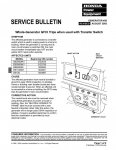kwired
Electron manager
- Location
- NE Nebraska
Maybe they do it differently in your part of the country, but I have not seen anything that does not come with the oil already in it here, this includes pressure washers, lawnmowers, ect. All of the Generac Guardian generators arrived at our warehouse full of oil. Now the larger generators do not come with oil, but is added by the startup mechanic.
Do you purchase them still packed in the box or does the store do any required assembly and add the oil? They will not have any fuel in them at all because fire codes will not allow that in the store. Units that are display models will have had all assembly and oils added by store employees when setting them up for display - but no fuel.



